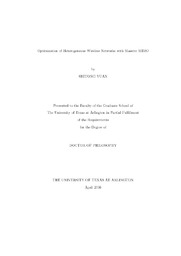
ATTENTION: The works hosted here are being migrated to a new repository that will consolidate resources, improve discoverability, and better show UTA's research impact on the global community. We will update authors as the migration progresses. Please see MavMatrix for more information.
Show simple item record
| dc.contributor.advisor | Liang, Qilian | |
| dc.creator | Yuan, Shitong | |
| dc.date.accessioned | 2017-09-13T14:27:25Z | |
| dc.date.available | 2017-09-13T14:27:25Z | |
| dc.date.created | 2016-05 | |
| dc.date.issued | 2016-05-13 | |
| dc.date.submitted | May 2016 | |
| dc.identifier.uri | http://hdl.handle.net/10106/26920 | |
| dc.description.abstract | In the next generation wireless communication system, multi-layers of Heterogeneous Networks (HetNets) are required to provide high efficiency bandwidth usage and high speed data throughput. Users’ distribution and their quality of service (QoS) request are random, and the number of users may vary through the time. In order to deal with this problem, this thesis builds two games’ models to optimize the resource allocation corresponding to different situations in the first chapter. The spectrum efficiency is analyzed and compared between two games. By playing those games, cells can serve more users inside one cell, and all users are fair to share the bandwidth according to their requests and locations. The whole system becomes more flexible and performance has been enhanced.
Further, we consider massive MIMO in a two-layer Heterogeneous Cellular Network. The system has a large self-interference and co-channel interference due to full-duplex mode operation. A two-layer HetNets system model is proposed with Massive MIMO in Full-duplex mode. By using Game Theory, an optimized system sum-rate is achieved. We investigate the potential sum-rate before and after the optimization under the power constraints(both single user power constraint and power constraint at base station). It is shown that after the game theoretical method applied, the system performed a very good access scheduling compare to random access. Compared to non-optimized model, game theoretical method can achieve higher sum-rate.
A novel antenna placement scheme at base station is proposed based on 2-D nested array. We utilize the difference co-array to model and generate all antennas(virtual antennas) in the covariance matrix of channel(virtual channel) coefficients. We also model a Massive MIMO antenna system with nested configuration and list all mathematical procedures to calculate its performance with achievable rate. A zero forcing detector is applied to this Massive MIMO system and the spectral efficiency is given at the end. Given the same number of antennas, the proposed method could achieve higher sum-rate capacity and better spectral efficiency.
The Massive MIMO usually considers the azimuth angle only. However, in a 3D distributed antenna system, the elevation angle cannot be ignored. Nested array as a two dimensional arrays was firstly proposed to perform array processing with increased degree of freedom, using less number of sensors at the same time. A novel 3D MIMO antenna deployment is also proposed based on nested co-array. We model a 3D nested distributed MIMO system and analyze its performance with achievable sum rate. | |
| dc.format.mimetype | application/pdf | |
| dc.language.iso | en_US | |
| dc.subject | Heterogeneous networks | |
| dc.subject | Game theory | |
| dc.subject | Wireless communication | |
| dc.subject | Massive MIMO | |
| dc.subject | Nested array | |
| dc.title | Optimization of Heterogeneous Wireless Networks with Massive MIMO | |
| dc.type | Thesis | |
| dc.degree.department | Electrical Engineering | |
| dc.degree.name | Doctor of Philosophy in Electrical Engineering | |
| dc.date.updated | 2017-09-13T14:29:32Z | |
| thesis.degree.department | Electrical Engineering | |
| thesis.degree.grantor | The University of Texas at Arlington | |
| thesis.degree.level | Doctoral | |
| thesis.degree.name | Doctor of Philosophy in Electrical Engineering | |
| dc.type.material | text | |
| dc.creator.orcid | 0000-0003-1310-3749 | |
Files in this item
- Name:
- YUAN-DISSERTATION-2016.pdf
- Size:
- 1.910Mb
- Format:
- PDF
This item appears in the following Collection(s)
Show simple item record


